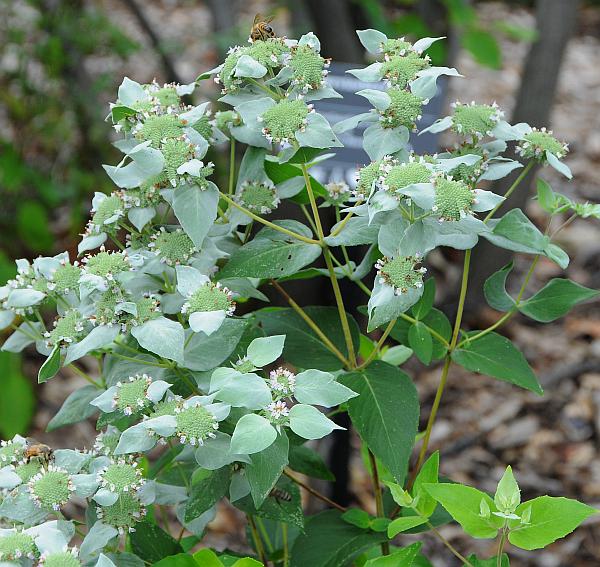Pycnanthemum muticum (Michx.) Pers.
Clustered Mountain Mint

Native
CC = 10
CW = 0
MOC = 7
SRank = S2
© SRTurner
Pycnanthemum muticum (Michx.) Pers.Clustered Mountain Mint | |
 |
Native CC = 10 CW = 0 MOC = 7 SRank = S2 |
© SRTurner |
|
Family - Lamiaceae Habit - Rhizomatous perennial forb. Stems - Ascending to erect, to 1.1 m, 4-angled, branching toward the tip, moderately to densely pubescent on the angles and sides with mostly short, curled hairs, occasionally with a few longer, spreading hairs. Leaves - Opposite, simple, sessile or nearly so. Blades 3-8 cm long, 15-40 mm wide, ovate to broadly lanceolate or oblong-ovate, mostly rounded to cordate at the base, the margins usually finely toothed, the upper surface glabrous or sparsely short-hairy, mostly along the veins (rarely the uppermost pair whitened with dense, short, curled hairs), usually green, the undersurface usually green, glabrous or sparsely to moderately short-hairy, mostly along the veins.
Inflorescences - Relatively dense, headlike clusters at stem and branch tips, often appearing broadly rounded, often appearing sessile or nearly so, only the lowermost branches observable. Bracts leaflike, whitened with dense, short, curled hairs on the upper surface, glabrous or nearly so on the undersurface. Bractlets 1-3 mm long, linear to narrowly lanceolate.
Flowers - Calyces 3-5 mm long, actinomorphic, bell-shaped, densely pubescent with minute, appressed hairs, mostly above the midpoint, lacking longer bristly hairs on the margins or tip, the lobes all similar in size and shape, 0.5-1.5 mm long, narrowly triangular, sharply pointed. Corollas zygomorphic, 4-7 mm long, white to pale pinkish-tinged or pale lavender, the upper lip 2-lobed, the lower lip 3-lobed with purple spots. Stamens 4, the lower pair with slightly longer filaments than the upper pair, the anthers small, the pollen sacs 2, parallel, usually light to dark purple. Ovary deeply lobed, the style appearing nearly basal from a deep apical notch. Style exserted, more or less equally 2-branched at the tip.
Fruits - Dry schizocarps, separating into usually 4 nutlets, these 1.0-1.4 mm long, obovoid or oblong-ellipsoid, rounded or bluntly pointed at the tip, somewhat 3-angled, the surface dark brown to nearly black, glabrous. Flowering - July - September. Habitat - Bottomland forests, ditches, roadsides, grassy disturbed areas. Origin - Native to the U.S. Lookalikes - P. albescens. Other info. - This species of mountain mint is uncommon in Missouri, occurring in a few counties near the Bootheel. Beyond Missouri it ranges southward and eastward, reaching the Gulf and Atlantic coasts in somewhat scattered fashion. The plant is recognized by its whitened upper leaves and bracts, and tight inflorescences of small white flowers with purple spots on the lower lip. The general appearance is very similar to the more common lookalike P. albescens, but that plant has looser inflorescences and leaves which are tapered at the base rather than rounded or truncate. The two species have been known to hybridize. Photographs taken at Otter Slough Conservation Area, Stoddard County, MO, 7-18-2009, at Missouri Botanical Garden, St. Louis, MO, 8-18-2014, and Otter Slough Conservation Area, Stoddard County, MO, 8-16-2021 (SRTurner). |